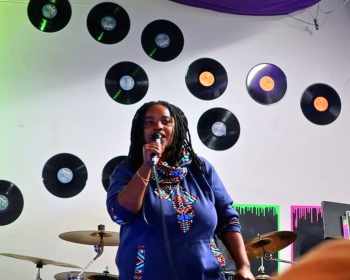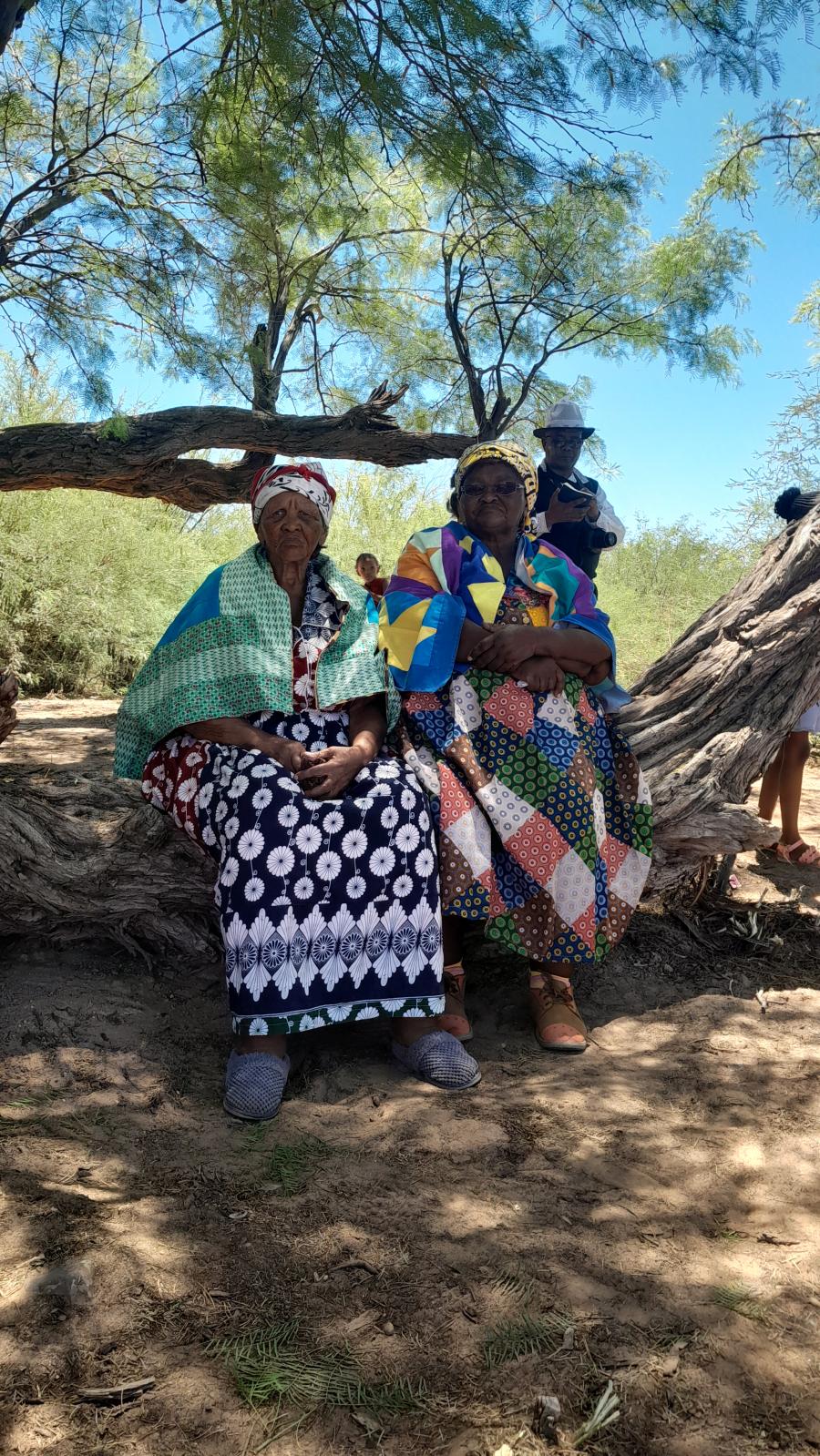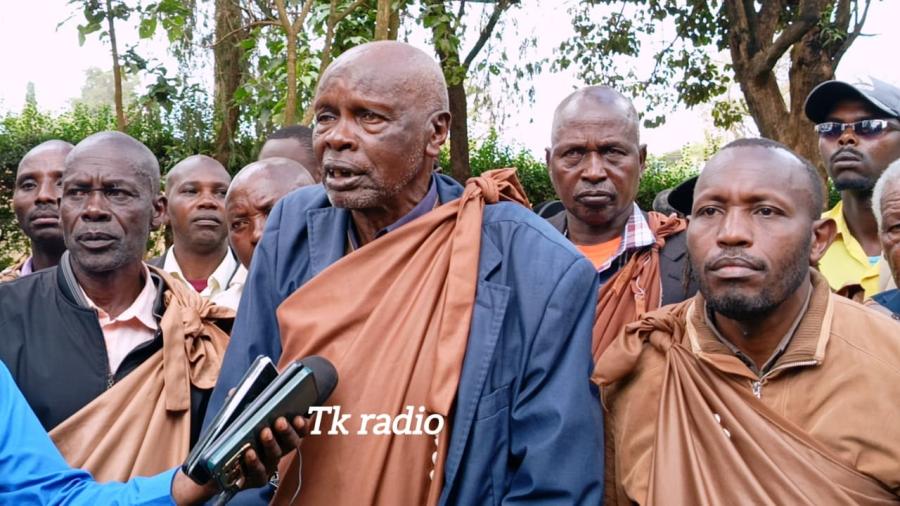In the remote, arid, northwestern corner of Namibia, a Himba headman and his councilors mete out a punishment to two young men who used an old rifle to shoot a gemsbok. The headman gives them a warning, and their fathers are fined two goats each. The community's game guard, Ngevi Tjikuta, had tracked and caught the two offenders a few weeks earlier. later in the month, government nature conservator Chris Eyre and the headman decide whether to take this relatively minor case any further. Ngevi feels that the youths have been taught an adequate lesson.
A couple of hundred miles to the south, community game guard Piet Hizerako, o his way to water his herd of goats, noted elephant tracks heading southeast, away from the spring - following a route elephants haven't used for months. Later, Piet detours to call on two Damara small-stock farmers, putting them on alert for poachers. If the elephants try to drink at a farm dam and find no water, they might damage the borehole (well) pipes. Thanks to a program funded by the World Wide Fund for Nature International (WWF), the farmers have been issued with a quantity of free diesel fuel to pump water for the elephants.
On the other side of Namibia, in the territory known as the East Caprivi, community game guard Beven Munali rides in a mukora (a canoe dug out of a jackalberry tree trunk) on the Kwando River. Spotting three rare sitatunga (a swamp-adapted antelope), he makes a mental note to include this sighting in his monthly report to his village induna (headman). Once a month, he and the induna pass on such information, via field officer Matthew RIce, to the Linyanti Tribal Khuta (court) and to Jo Tagg, the Ministry of Wildlife, Conservation, and Tourism's senior officer in the area. Two decades of heavy poaching have reduced once abundant wildlife to remnant populations of most species.
In the 125-mile-long West Caprivi strip between the Kavango and Kwando rivers, home of more than 5,000 Khoe and Vasekele Bushman people, government game rangers and an antipoaching squad, alerted by two Khoe community game guards, follow the tracks of men who have crossed into the Caprivi from neighboring Zambia. Chances are high that the Zambians are armed poachers looking for ivory.
COMMUNITY-BASED CONSERVATION
The key to the success of the community game-guard program in namibia, according to Garth Owen-Smith, a nature conservator who 11 years ago left a government post at Etosha National Park, is that it forges a team effort among local people, government workers, and nongovernmental organization (NGOs).
Piet, Ngevi, Bevan, and the two West Caprivians are five of Namibia's 90-plus community game guards. Several are ex-poachers. What they all have in common in a vast knowledge of their environment and the wildlife that inhabits it, plus the fact that none of them have enough formal education (most can't read or write) to quality for employment as game rangers in government service. Each man works for his own community, which chose him as community game guard. The guards don't work for the government conservation agency, although they do work in partnership with government rangers. Currently, their salaries are paid with funds raised mainly outside Namibia by WWF.
A number of communities in Namibia, the last of Africa's colonies to gain independence (in 1990), share responsibility with the government for managing and conserving one of the most valuable natural resources in their country: wildlife. Where such community-based programs are well established, wildlife has flourished. SInce independence, with government support and international funding, the network appointees across ethnically diverse Namibia.
With ecotourism poised to become Namibia's second-biggest generator of foreign exchange after mining, the country's wildlife in its starkly beautiful desert and mountain settings are central to the economy. However, many indigenous Namibians no longer experience wildlife as the resource it once was before the preservationist laws of colonial governments alienated local people from their natural resources. Today, with few exceptions, the benefits generated by wildlife go mainly to tour companies individual entrepreneurs, and the state treasury. All but the most menial jobs in tourism and nature conservation are filled by those with relatively high formal education, thus shutting out most of this wildlife or are neighbors of the game parks.
There have been attempts to change this situation. For example, the post independence Ministry of Wildlife, Conservation, and Tourism has launched a conservation program that will share with local rural communities both the responsibility for and the benefits from wildlife management. The Namibian government, in partnership with communities, in partnership with communities and NGOs, has built onto or started projects in a number of communal areas. Formerly ethnic "homelands," these areas are state-owned tribal lands as opposed to other areas in Namibia that are owned by individuals. In West Caprivi, a game reserve formed in 1968 but run by the South African Defense Force (SADF) until independence is home to about 5,000 Khoe and Vasekele San, or Bushman, people. Other projects are in East Bushmanland with the Ju/wa people; in the western part of East Caprivi inhabited by the Mafwe, Bayeyi, and Mbukushu; and on the! Khuiseb River where the Topnnar people live.
The first stage of the national program involves a social and ecological survey of each communal area in which wildlife survive, in order to draw up a natural resource management plan with - not for - the local community, as was done in the past. Thus, each area's plan will be unique, adapted to the needs of the local people and environment. What the plans share are grassroots community structures for joint decision-making with government, shared responsibility and accountability for managing wildlife and other natural resources, and the promotion of local benefits from the varied uses of wildlife, including tourism.
NAMIBIA'S COMMUNITY GAME GUARDS
Local leaders appointed the first six NGO-sponsored community game guards in 1982 in what used to be called the Kaokoveld, today part of the new Kunene Province in northwest Namibia, Although the men played a major role in turning around the most serious commercial poaching epidemic of black rhino and desert-adapted elephant that Namibia had faced, the program remained small - tapping local southern African funding - until independence. That same year, WWF came in as the major sponsor and, with the blessing of Nico Bessinger, the new Minister of Wildlife, Conservation, and Tourism appointed by the South West African Peoples Organization (SWAPO). the Kaoka initiative expanded and community game-guard networks started up in other parts of Namibia, including West and East Caprivi.
One of the Program's key prerequisites is commitment from the local community to support the conservation and sustainable utilization of their natural resources, including wildlife. Joshoa Kangombe of Warm Quelle, one of the headman who founded the original game-guard program more than 10 years ago, recalls that in the Kaokeveld in the early 1980s everyone hunted: local people, SADF officers, and white officials of South West African government. "We saw the wildlife going down. No one would have though it possible, but we could see that if the killing continued there would soon be no game to show to our unborn children. But we felt powerless to do anything."
The power to stop the slaughter grew out of meetings among Joshua, other senior Herero and Damara men, government officials, and Garth Owen-Smith, formerly of Etosha National Park. Owen-Smith takes up the story:
We had a serious poaching problem with little hope of government being able to bring it under control. The Kaokoveld's elephant population was reduced from more than 1,000 to about 250; black rhino went from more than 350 to below 65. There were only two government nature conservation officials, Chris Eyre and Lucas Mbomboro, in the entire area of about 40,000 square miles. Our NGO operation had a field staff of three. There was no way that five men could cover an area bigger than West Germany.
In our discussions with senior Herero, Himba, and Damara men, we discovered that they too were appalled at the scale of poaching. From that common ground, the community game-guard network evolved. Local communities had manpower; vast knowledge of the area, its wildlife, and the local people; we had a small staff, some funds, plus a few vehicles to help coordinate the operation. Some of our sponsors were skeptical that people from within the local communities could become part of the solution, but we managed to scrape together enough cash to fund six posts. The rest is history.
In the past decade, the Kaokoveld's wildlife numbers have increased dramatically. The small but now thriving black rhino population is today well protected on three levels. The community game guards, who represent grassroots community support, make it extremely difficult for any outsider to venture into the area unnoticed. In another NGO-government initiative, local men regularly monitor rhino populations, all of which are recorded on a central rhino "identikit." This second tier of protection builds on the first and backs up a third level, the government's antipoaching and law-enforcement efforts.
With numbers of all species up, the Ministry of Wildlife, Conservation, and Tourism has undertaken three game harvests - in 1987, 1988, and 1991 - delivering fresh zebra, springbok, gemsbok, and giraffe meat to villagers and schools. Ecotourism is booming and, with NGO help, several local entrepreneurs have set up tourist campsites.
Such action to assist individual businesspeople do not, however, go far enough on communal lands, and NGOs and others are seeking ways to return benefits directly to whole communities that live with wildlife. In a small pilot project in effect since 1987, a Himba community in the Purros area receives a (voluntary) tourism tax, as caretakers of the wildlife, from the tour operator who uses its area. The project aims to show that wildlife can generate direct cash benefits to local people. It also attempts to facilitate a more structured and dignified relationship between tourists and local residents.
HARNESSING INDIGENOUS KNOWLEDGE
Although each network of game guards operated slightly differently based on the policies of a community and its leaders, the networks share several common principles. Perhaps most important, the program provides a mechanism for program provides a mechanism for local people to actively participate, with government, in managing natural resources. It also harnesses the people's store of indigenous knowledge and, on its own terms, integrates that knowledge into modern conservation.
This new relationship between communities and government officials is fundamental is a post-colonial state with a history of apartheid. "In the past nature conservation officials came into our homes to kick the lids off our cooking," says one community leader. "Now they come with respect to talk to us about the nature conservation work we are doing together."
Other advantages of the community game-guard system to a developing African state are its low cost and the fact that it is people centered and requires no hightech inputs. The total cost of 15 community game guards runs around R 100,000 (about) $35,000) a year, including logistical support. Although WWF and other outside funders currently meet these expenses, eventually the community hopes to use income from wildlife and tourism to meet the costs of game guards.
Some government game rangers, black and white, will need time to accept community game guards, due partly to resentment that men with little formal education appear to be challenging the more elite positions of government officials, which require over 10 years of Western-style schooling. Government nature-conservation staff also traditionally see wildlife as entrusted to their care. The new communitybased approach requires conservation staff to share that responsibility with local people - to give away some of their power.
Resistance to indigenous knowledge and value systems often appears strongest among recently qualified technocrats, who see traditional knowledge as backward or even antidevelopment. One young agricultural extension officer puts his dilemma this way: "I spent 10 years at school and three years at agricultural college, and now you tell me I must listen to my illiterate grandfather's ideas about farming!"
Another problem facing community based conservation in Namibia is that many Western-educated government officials, including some Namibians who left the country during the independence struggle, see sedentary agriculture and commercial stock farming as the only development model for rural Namibia, even though such Eurocentric impositions have usually failed in Africa. Wildlife is associated with the past, not with Namibia's future economic development.
At a recent workshop, officials of one of the new government's ministries mocked Namibian Bushmen who talked about a land-use plan that integrated wildlife management areas with mixed farming and gathering zones: "Forget about wildlife," one official said. "Now that we are independent, even you Bushmen must develop. You should be growing maize, not worrying about wild animals." The fact that the Bushmen were discussing game farming and that the live sale of a single eland or roan antelope could earn up to $10,000, far surpassing the area's agricultural or domestic stock potential, passed the official by.
Article copyright Cultural Survival, Inc.



